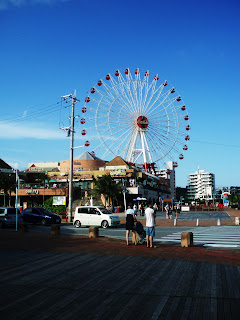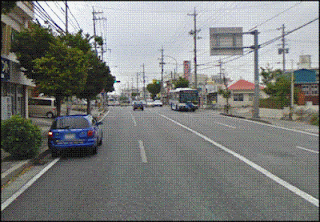The Haunted Hotel - Full of Mystery
The Haunted Hotel on Okinawa is an incredible structure filled with mystery, many stories, and even more questions. It is located on a hill right next to Nakagusuku Castle. The pictures in this post were all taken while touring Nakagusuku Castle.
It is located on a hill right next to Nakagusuku Castle. The pictures in this post were all taken while touring Nakagusuku Castle.Note: Before I go any further, visiting the Haunted Hotel is probably illegal (there are lots of signs), and certainly dangerous.
Thus, I do not suggest anyone actually go to it, and I may or may not have ever been there, and I have certainly never climbed to the 5th floor and thrown a toilet off of it.
Now that that's cleared up...
Many Questions, Few Answers Surround the Haunted Hotel on Okinawa
The Haunted Hotel is one of those places where you can't help but wonder what it was really supposed to be, and what it would have been like if it were completed. It is a huge structure that sprawls on top of, and around a hill in Nakagusuku village. The construction does not seem to have been very organized; it seems to have been built adding a section at a time, with no master blueprint to guide the builders.
It is a huge structure that sprawls on top of, and around a hill in Nakagusuku village. The construction does not seem to have been very organized; it seems to have been built adding a section at a time, with no master blueprint to guide the builders.The Haunted Hotel does not seem like a normal hotel.
There is no viable parking anywhere near the Haunted Hotel. Where would the guests have parked?
There is no easy way to get to the Haunted Hotel. Perhaps over time the original road that led to the hotel has been closed or removed, but even the road that runs through the middle of the structure is small, and unlikely to be used as a real road.
There are no main hallways or straight paths. In most hotels, the layout is very simple to keep guests from getting confused or lost. But at the Haunted Hotel, the walkways are anything but straight. They circle around, go up, go down, take sharp corners, and even end in a dead end.
Some hallways are even stranger in that they get too small for an average person to walk through. One has to bend over to continue walking through. And these hallways connect to major portions of the hotel, so why would they make it so only people under 4' 10" could easily walk through?
And let's not even get into the odd shaped guest rooms, and stairs to nowhere.
The Story Behind the Haunted Hotel
It is hard to tell for sure what the real story behind the Haunted Hotel is, but based on many different peoples' responses, including several Japanese native to that area, it goes something like this:Sometime in the 1970's a Japanese Business man from Naha (or somewhere other than Nakagusuku) decided to buy the land on the mountain next to Nakagusuku Castle, and build a hotel there.
He planned for an impressive hotel, and it was going to be called The Royal Hotel.
Plans seemed to be falling in place, he had a great location with a beautiful view of the ocean (some say it is the best view on Okinawa) and plenty of money to get the project underway.
Unfortunately, the locals in that area strongly warned the businessman to stop his plans because the ground was sacred and filled with spirits. .
The proximity to Nakagusuku castle and a sacred Buddhist cave and shrine as well as many old tombs on the hill should have been enough to convince the man to build his hotel elsewhere, but he did not.
The Nakagusuku Castle dates back hundreds of years, to around the 14th century AD. Who knows what could have occurred in all that time on the hill next to the castle? Perhaps it was the burial ground for the castle.
As construction got underway, strange and scary things began to occur. Workers began dying in odd construction accidents.
Some workers quit, others stayed on, but construction slowed after these mysterious deaths.
It is hard to know the exact sequence of events, but at some point the businessman's son died and the father went insane.Perhaps possessed by spirits.
I believe construction continued for a little while after the businessman went insane, which would explain the haphazard design and confusing layout.
Eventually all the workers who had stayed around decided to quite before they too were killed, and construction was stopped.
The businessman had used millions on the hotel, and all that was left was a half completed gigantic sprawling structure.
Some say the businessman lived at the hotel for several years and even died there.
It is a strange and eerie story with plenty of room for myths and legends to get mixed into the facts.
But the hotel that is left behind from the story says a lot as far as confirming that it has a mysterious and unsettling history.
Experiences at the Haunted Hotel
Many people have visited the Haunted Hotel over the years and one could probably write a book about the various experiences. Some people claim to have seen ghosts in the form of the businessman, workers or even the child while others suggest seeing ghosts from hundreds of years ago.Many pictures have been taken at the Haunted Hotel that contain ominous orbs in the photos which indicate some sort of energy at that location.
Some visitors have said they heard very unnerving sounds that followed them through the hotel as they explored it, sounds that were unlike anything they had heard before.
Others noticed flashlights and other electronic devices failing when entering certain rooms.
One thing is sure, if anyone is looking for an adventure, the Haunted Hotel has enough mystery to last many adventures.

Other Extremely Odd Facts About the Haunted Hotel
 |
| A Favela in Brazil looks similar to the Haunted Hotel By Natecull |
- There are piles of unused construction materials that have simply been left behind.
- There is a water park that was going to be part of the hotel on one side of the hill.
- There is a zoo with very eerie cages and bars that have been bent and broken.
- One could spend en entire day walking around and through the hotel and still not see everything.
- The walkways, steps and hallways tend to be uneven, as if built by inexperienced builders or at the direction of someone who could have been insane.
- The sprawling construction and haphazard placement of connected buildings and rooms looks more like a Favela in Brazil than a planned structure.





